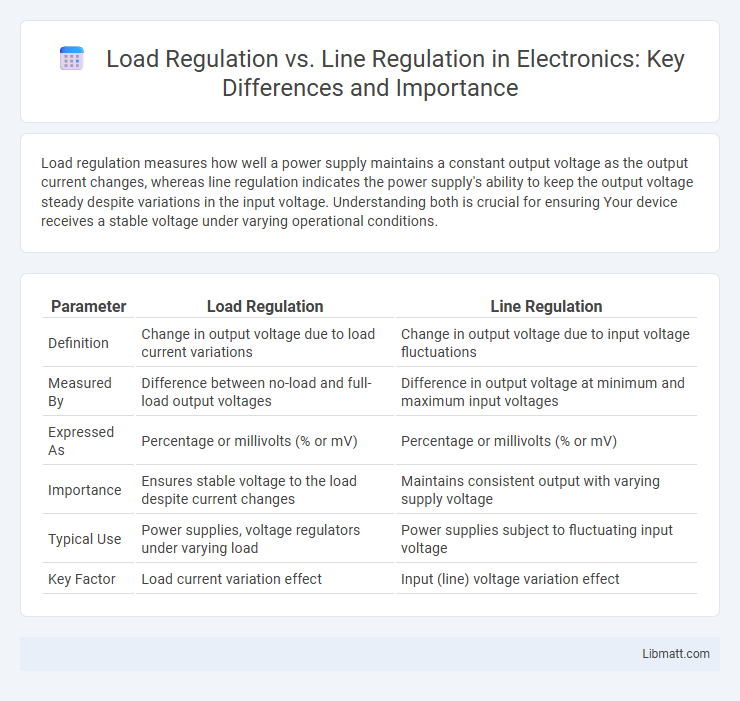Load regulation measures how well a power supply maintains a constant output voltage as the output current changes, whereas line regulation indicates the power supply's ability to keep the output voltage steady despite variations in the input voltage. Understanding both is crucial for ensuring Your device receives a stable voltage under varying operational conditions.
Table of Comparison
| Parameter | Load Regulation | Line Regulation |
|---|---|---|
| Definition | Change in output voltage due to load current variations | Change in output voltage due to input voltage fluctuations |
| Measured By | Difference between no-load and full-load output voltages | Difference in output voltage at minimum and maximum input voltages |
| Expressed As | Percentage or millivolts (% or mV) | Percentage or millivolts (% or mV) |
| Importance | Ensures stable voltage to the load despite current changes | Maintains consistent output with varying supply voltage |
| Typical Use | Power supplies, voltage regulators under varying load | Power supplies subject to fluctuating input voltage |
| Key Factor | Load current variation effect | Input (line) voltage variation effect |
Introduction to Load Regulation and Line Regulation
Load regulation measures a power supply's ability to maintain a constant output voltage despite variations in the connected load, ensuring stable device performance. Line regulation quantifies how effectively the power supply maintains output voltage stability when the input voltage fluctuates within its specified range. Understanding these parameters helps you assess the reliability and efficiency of power supplies in electronic circuits.
Definitions: What is Load Regulation?
Load regulation measures a power supply's ability to maintain a constant output voltage despite changes in the connected load current. It is expressed as the percentage change in output voltage when the load varies from full load to no load or from one predetermined load condition to another. This parameter is critical for ensuring consistent device performance under varying operational demands.
Definitions: What is Line Regulation?
Line regulation measures a power supply's ability to maintain a constant output voltage despite variations in input voltage. It quantifies how well the device stabilizes output voltage when the supply line voltage fluctuates, expressed as a percentage or millivolts per volt change. Your power system's reliability depends on minimal line regulation to ensure consistent performance under varying electrical conditions.
Key Differences Between Load and Line Regulation
Load regulation measures the voltage stability as the output current varies, ensuring your device receives consistent power under changing loads. Line regulation assesses voltage stability against input voltage fluctuations, safeguarding performance during supply changes. Understanding these key differences helps optimize power supply design for reliable electrical performance.
Importance of Load Regulation in Power Supply Design
Load regulation is critical in power supply design because it ensures the output voltage remains stable despite variations in the load current, maintaining consistent device performance and preventing damage. Precise load regulation improves the reliability and efficiency of electronic systems by minimizing voltage fluctuations that can lead to overheating or erratic behavior. Understanding load regulation helps you optimize power supply designs to deliver accurate and stable voltage under varying load conditions.
Significance of Line Regulation in Voltage Stability
Line regulation is critical for maintaining voltage stability by minimizing voltage variations caused by fluctuations in input supply voltage. It ensures your power supply delivers consistent and reliable voltage output despite changes in line voltage, preventing potential damage to sensitive electronic components. Effective line regulation helps maintain overall system performance and protects against power disturbances.
Factors Affecting Load and Line Regulation Performance
Load regulation performance is primarily influenced by variations in the output current, output impedance, and the power supply's ability to maintain a stable voltage under dynamic load conditions. Line regulation depends on the power supply's ability to handle input voltage fluctuations, influenced by the internal reference voltage accuracy and the quality of the voltage regulator components. Your choice of components and circuit design plays a crucial role in optimizing both load and line regulation to maintain consistent device performance.
Practical Applications: Where Load and Line Regulation Matter
Load regulation is critical in power supply designs where varying output current demands impact voltage stability, such as in battery chargers and LED drivers. Line regulation becomes essential in environments with fluctuating input voltages, like renewable energy systems or uninterruptible power supplies, ensuring consistent device performance. Understanding both helps you optimize power delivery in sensitive electronics, maintaining operational reliability despite load or input voltage changes.
Measuring and Testing Load vs Line Regulation
Measuring load regulation involves varying the load current on a power supply and observing the output voltage change to ensure stability under different load conditions. Testing line regulation requires altering the input voltage within specified limits and monitoring the output voltage variation to assess the power supply's ability to maintain a constant output. Precise instruments such as source meters and digital multimeters are essential for capturing accurate voltage fluctuations during both load and line regulation tests.
Tips for Optimizing Load and Line Regulation in Circuits
Optimizing load regulation involves minimizing output voltage variation caused by changes in load current, achieved by selecting low-output-impedance regulators and using proper feedback compensation. Line regulation optimization requires maintaining stable output voltage despite input voltage fluctuations, often accomplished by employing voltage references with high power supply rejection ratio (PSRR) and ensuring clean, stable input supplies. Careful PCB layout, including short high-current paths and adequate decoupling capacitors, significantly enhances both load and line regulation performance in power supply circuits.
Load regulation vs Line regulation Infographic

 libmatt.com
libmatt.com